Abstract
The Soarinho Alkaline Intrusion, southeastern Brazil, makes up part of the Serra do Mar Igneous Province, and it is composed of alkali feldspar syenite, alkali feldspar trachyte, quartz syenite, and monzonite. Geochemical and geochronological analyses of the Soarinho were compared with data from its neighbors, Rio Bonito and Tanguá. Zircon U-Pb Laser Ablation ages show that Soarinho is younger than Rio Bonito and Tanguá. Ages obtained from the monzonite (60 ± 2 Ma), alkali feldspar syenite (58 ± 2 Ma), and quartz syenite (58 ± 2 Ma) are indistinguishable within error. One nepheline syenite sample from Tanguá gives an age equal to those of Rio Bonito already published (65 ± 1 Ma). Petrographic and geochemical data show a clear contrast among Soarinho, Rio Bonito, and Tanguá. Lu-Hf isotopic data for the three alkaline intrusions (all negative) point to some similarities in their sources. The data suggest an enriched mantle source for Soarinho; however, an older continental crust contribution cannot be discarded.
1. Introduction
The magmatism present within Brazil of Meso-Cenozoic age is normally associated with two large magmatic events registered in the South American Platform during its formation. Pre- and syn-rift tholeiitic magmatism is the oldest of these events (133–120 Ma), which is associated with Gondwana break-up, the South Atlantic Ocean opening, and Brazilian continental margin rift basins [1,2,3]. The second event is the alkaline magmatism that occurred during the separation of the South American and African plates. Alkaline occurrences distributed across Brazil formed Provinces mainly concentrated along the borders of the Paraná Basin as follows: Anitápolis (132 Ma), Iporá (90–80 Ma), Alto Paranaíba (85 Ma), Poxoréu (84 Ma), Lages (80–75 Ma), and Serra do Mar (85–55 Ma) [4,5,6].
Serra do Mar Igneous Province (SMIP) (Figure 1) intrudes the metamorphic basement of the Brasiliano (Pan-African) Ribeira Mobile Belt (part of the Mantiqueira Province), which abuts the southern margin of the Archaean São Francisco Craton [6]. This metamorphic basement comprises migmatites, several types of gneisses, charnokites, and granites with a complex structural geology [7,8].
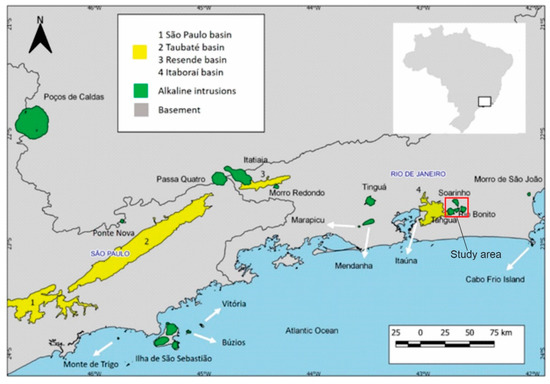
Figure 1.
Map of the Serra do Mar Igneous Province.
Nowadays, it is estimated that alkaline magmatism represents about 2% of igneous rocks mapped around the World. Despite being rare, this kind of magmatism is well represented on Brazilian territory [4,5,6]. The Serra do Mar Igneous Province, located in Southeastern Brazil, represents a series of alkaline igneous complexes that developed between the Cretaceous and the Eocene [6]. In SMIP, predominant stocks and plugs comprise silica-undersaturated rocks beyond mafic dyke swarms (alkali basalts, basanites, mela nephelinites, and lamprophyres).
The geochronological data (K-Ar, Rb-Sr, and U-Pb) presented to the SMIP gave rise to intense discussions about the geodynamical model that explained the emplacement of those alkaline rocks in Southeastern Brazil [9,10,11,12,13,14]. The first model is based on the age decrease from west to east (Figure 1) and proposes that this decrease elapses in the passage of the lithosphere over a mantle plume [4,15,16]. The second model proposed for SMIP magmatism points to an irregular decrease in ages and suggests structural control over the emplacement of those igneous bodies [17,18,19]. Finally, the third model points to a combination of evolution between a mantle plume and structural control [20].
Works based on Nd and Sr isotopes demonstrate isotopic signatures with mantle affinity for the igneous bodies in SMIP. Despite the mantle signature being present on all igneous bodies of SMIP, the same isotopic data demonstrated heterogeneity between different igneous bodies and individual heterogeneities [5]. Sr isotopic data demonstrated that different portions of the mantle contributed to the SMIP magmatism and different levels of mantle enrichment [6,21,22]. However, lithogeochemical data from previous works demonstrate some level of crustal contribution to the SMIP magmatism, even if it did not play a fundamental role in the genesis of these igneous bodies [22,23,24,25].
After decades of study at SMIP, some igneous complexes are better understood than others, such as the Poços de Caldas and Itatiaia complexes, which have detailed mapping, in addition to geochronological, geochemical, and isotopic data [25,26,27,28,29,30,31]. On the other hand, some complexes, such as Soarinho (the focus of this work), received less attention. Therefore, the purpose of this work is to present a geochemical, geochronological (U-Pb), and isotopic (Lu-Hf) study for the Soarinho intrusive complex (Rio de Janeiro, Brazil). We also present U-Pb and Lu-Hf data from Tanguá, comparing them with Rio Bonito’s published data [14]. Finally, the Lu-Hf data has the potential to add knowledge about possible sources of evolved alkaline magmas.
2. Soarinho Intrusive Complex
The Soarinho Complex is intruded on rocks of the Oriental domain (Ribeira belt), specifically on the Costeiro domain [7] (Figure 2). The country rocks of the Soarinho Complex are the syn-collisional granites (Cassorotiba orthogneiss) and paragneiss of the São Fidélis group (Figure 2). The Soarinho complex forms an elongated stock in the NNW-SSE direction, with an area of 33 km2 and a maximum elevation of 600 m.
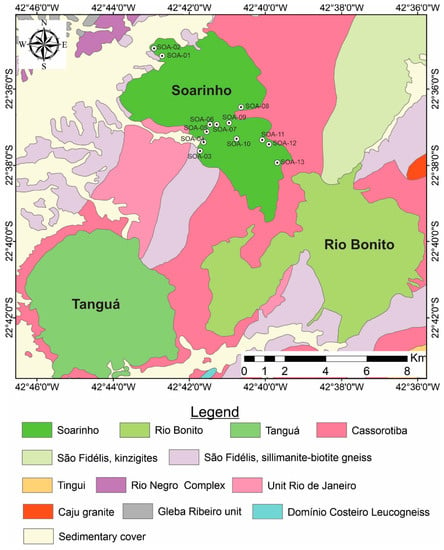
Figure 2.
Map of the Soarinho alkaline massif, including sampling sites.
The Soarinho Complex is composed of alkali-feldspar syenite, alkali-feldspar trachyte, monzonite, quartz syenite, magmatic breccias, and lamprophyres [6]. The lack of nepheline is a striking feature in Soarinho, with some rocks showing modal quartz. In the north segment, there are quartz syenite, monzonite, and silica-undersaturated syenite, and in the south segment, the same silica-undersaturated syenite predominates [32].
Tanguá and Rio Bonito Massifs
Rio Bonito and Tanguá are comprised mainly of nepheline syenite and syenite cut by phonolite and trachyte dykes [32]. Both massifs have a concentric zoning characterized by an increase in modal nepheline content from the border to their core [32]. Magmatic breccia also occur in Rio Bonito and Tanguá, with the latter’s NE-SW trend concordant with phonolite and trachyte dykes. Such breccia consist of millimetric to centimetric fragments of trachytes, phonolites, and rarely syenites and gneiss. Locally, in the center of the intrusion, Tanguá presents pseudoleucite syenites. Fluorite veins parallel to the phonolite and trachyte dykes have been economically explored in Tanguá for decades [33].
3. Analytical Methods
Sixteen samples were collected, which were prepared for the geochemical analyses in the Laboratório Geológico de Preparação de Amostras (LGPA) at Rio de Janeiro State University. The procedures for extracting zircons for U-Pb dating were also realized in this laboratory.
The multielementary lithogeochemistry analysis was carried out at Activation Laboratories Ltd. in Canada. The major elements (SiO2, Al2O3, Fe2O3T, MnO, MgO, CaO, Na2O, K2O, TiO2, and P2O5) have their concentrations measured in weight percentage. The mobile trace elements (Ba, Rb, Sr, U e Th), immobile trace elements (Zr, Y, Nb e Hf), and rare earth elements (La, Ce, Pr, Nd, Sm, Gd, Eu, Tb, Dy e Ho), in addition to Ni, Cr, V, and Co, were measured in parts per million. In this analysis, we also obtained Loss on Ignition (LOI) information. Geochemical data was handled by the GCDKit program [34].
Zircon grains were separated using conventional heavy liquid and magnetic techniques, and the grains were handpicked under a binocular microscope. These zircon grains were mounted onto an epoxy resin disc and polished to about half of the zircon modal grain thickness. Zircons were documented with backscatter (BSE) and cathodoluminescence (CL) images obtained to reveal their external and internal structures. BSE and CL imaging were performed at the Multilab at Rio de Janeiro State University.
The U-Pb dating and Lu-Hf isotopes were carried out in the MultiLab Laboratory from Rio de Janeiro State University and the Isotope Geochemistry Laboratory from Ouro Preto Federal University through the technique of Laser ablation Inductively Coupled Plasma Mass Spectrometer (LA-ICP-MS). The equipment used was Neptune from Thermo Scientific. The laser conditions applied in these analyses were a diameter of the spots between 30 and 85 µm and a frequency of 10 Hz. The data treatment parameters were discordance equal to or less than 5% and low common lead (a maximum of 0.05%). Isoplot software was used for constructing the Tera-Waserburg Concordia diagrams [35,36].
U-Pb data from Soarinho samples were carried out in the MultiLab Laboratory at Rio de Janeiro State University. The standard procedure used for the dating begins with the analysis of a blank; following that, the GJ1 zircon standard was used, and then nine shoots were made on the zircons of the analyzed sample. Following was an analysis of the 91,500-zircon standard, another analysis of the GJ1 standard, and finally another analysis of the blank. The unknown zircon analyses interleaved with standards of zircons have the purpose to make corrections of isotopic fractionations in addition to the blank corrections.
The U-Pb analysis of nepheline syenite from Tanguá was carried out in the Isotope Geochemistry Laboratory at Ouro Preto Federal University. The equipment is a Photon-Machines Laser Ablation system (G2 excimer laser at 193 nm) coupled to a ThermoFisher Scientific Neptune Plus MC-ICP-MS. The analyses are obtained in automated mode via a trigger cable between the laser and the MC-ICP-MS. After the laser triggers the ICP-MS, a 15 s background is measured, followed by a signal + background as the laser beam is activated for 40 s. It is applied using the standard-sample-standard bracketing technique, analyzing 5 points on primary and 5 points on secondary reference materials, followed by 10 points on unknowns, and back to 5 points on each reference material.
All Lu-Hf analyses were made in the Isotope Geochemistry Laboratory at Ouro Preto Federal University. Zircon Lu-Hf analyses were made at the same points dated by U-Pb. A Photon-Machine Laser Ablation system (ArF excimer laser 193 nm) coupled to a Neptune MC-ICP-MS was used to measure the Lu, Yb, and Hf isotopic signatures of the zircons. BB (Supplementary Material SA), Gj1 (Supplementary Material SB), and Plesovice (Supplementary Material SC) were the standards used in the Hf analyses.
The following calculations were applied to Lu-Hf analyses: 176Yb/177Hf = (176Yb/173Yb) true × (173Yb/177Hf) meas × (M173(Yb)/M177(Hf))b(Hf), b(Hf) = ln(179Hf/177Hf true/179Hf/177Hf measured)/ln (M179(Hf)/M177(Hf)), M = mass of respective isotope. The 176Lu/177Hf were calculated in a similar way by using the 175Lu/177Hf and b(Yb). The mean Hf signal is in volts. Uncertainties are quadratic additions of the within-run precision and the daily reproducibility of the 40ppb-JMC475 solution. Uncertainties for the JMC475 are quoted at 2SD (2 standard deviations).
The 176Hf/177Hf initial ratios and ƐHf were calculated using the 207Pb/206Pb apparent age determined by LA-SF-ICP-MS. The CHUR parameters are 176Lu/177Hf = 0.0336 and 176Hf/177Hf = 0.282785 [37]. The 176Lu decay constant is 1.867 × 10–11 year−1 from [38]. The following constants were used to calculate TDM values: avg. MORB [39], BLIC TDM [40], and NC TDM [41].
4. Soarinho Rocks Petrography
4.1. Quartz Syenite
Syenite quartz has a porphyritic texture with a fine- to medium-grained matrix and two types of phenocrysts: rounded orthoclase phenocrysts and plagioclase laths (Figure 3). The matrix consists of quartz, biotite, clinopyroxene, amphibole, opaque minerals (mainly magnetite), titanite, apatite and zircon. Orthoclase is the main mineral, has inclusions of quartz, opaque minerals, and zircon, and makes up about 68% of the modal composition. Plagioclase has compositional zoning as its main characteristic and makes up about 11% of the modal. Quartz is xenomorphic and represents approximately 6% of the modal composition. Biotite often occurs in tabular form and corresponds to 6% of the modal composition. Amphibole (5%) and clinopyroxene (1%) occur in anhedral granular form. Magnetite is xenomorphic and often rounded.
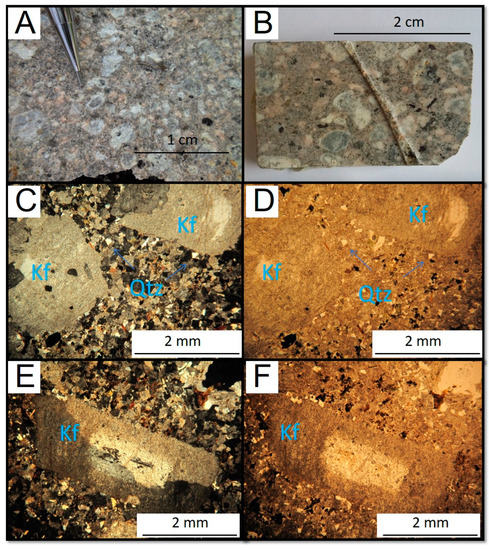
Figure 3.
(A,B) Hand specimen of the quartz syenite. (C–F) Photomicrographs of the quartz syenite. (C,E) cross-polarized light (xpl). (D,F) plane-polarized light (ppl). Kf = K-feldspar, and Qtz = quartz.
4.2. Monzonite
They are medium- to coarse-grained rocks composed of plagioclase, orthoclase, quartz, clinopyroxene, biotite, amphibole, apatite, opaque minerals (mainly magnetite), and zircon (Figure 4). Plagioclase is the main mineral of the rock; it comes in the form of laths and makes up about 45% of the modal composition. Orthoclase is granular and xenomorphic and corresponds to approximately 35% of the modal composition. The rock’s main mafic mineral is biotite, which is primarily xenomorphic and corresponds to about 12% of the modal composition. Clinopyroxene (augite) is round and granular and makes up about 3% of the modal composition. Amphibole (hornblende) is xenomorphic and is present in about 3% of the rock composition. Quartz has a granophyric texture, which represents only 2% of the modal composition.
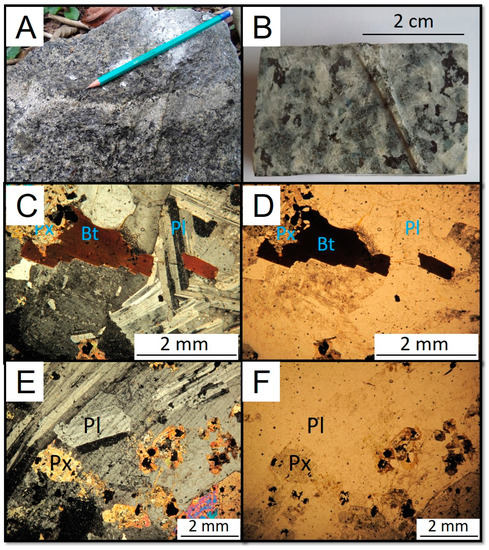
Figure 4.
(A,B) Hand specimen of the monzonite. (C–F) Photomicrographs of the monzonite. Bt = biotite, Px = pyroxene, and Pl = plagioclase.
4.3. Alkali-Feldspar Syenite
They are equigranular rocks, medium to coarse-grained, and light gray in color (Figure 5). The main mineral is orthoclase, which makes up about 90% of the rock, and has a granular habit and perthitic texture. Amphibole has a granular habit. Opaque minerals are xenomorphic and are associated with amphiboles.
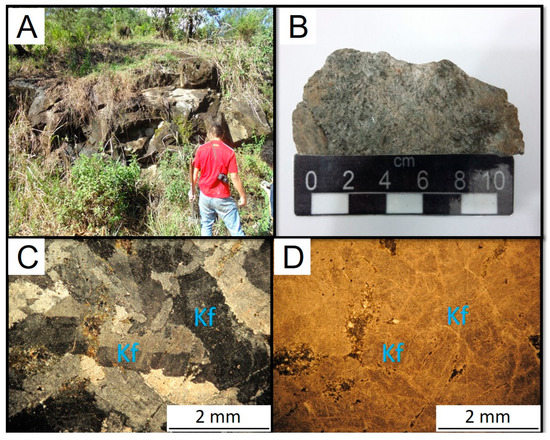
Figure 5.
(A,B) Hand specimen of the alkali feldspar syenite. (C,D) Photomicrographs of the alkali feldspar syenite. Kf = K-feldspar.
4.4. Alkali-Feldspar Trachyte
Fine-grained, grey to greenish-colored (Figure 6) microporphyritic rocks with phenocrysts of perthitic sanidine occurring as simple twinning lath grains. The matrix presents a typically trachytic texture and consists mainly of feldspar. Biotite is a submillimetric xenomorphic or tabular grain also occurring as clusters of micrograins. Amphiboles appear as micrograins or clumps of micrograins. Opaque minerals have cubic to rounded shapes, forming submillimetric grains.
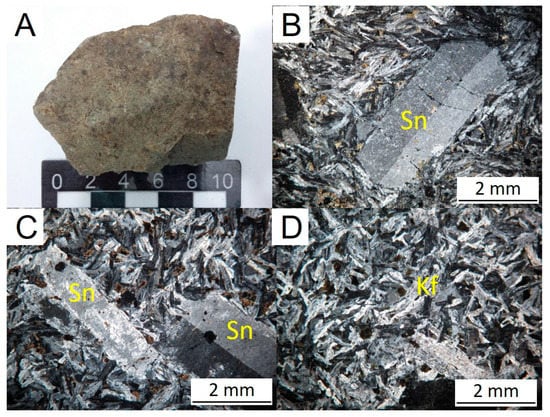
Figure 6.
(A) Hand specimen of the alkali feldspar trachyte. (B–D) Photomicrographs of the alkali feldspar trachyte. Sn = sanidine, Kf = K-feldspar.
5. Geochemistry
The geochemical data of the Soarinho complex are presented in Table 1 and Table 2. Analysis was carried out for the following lithotypes: alkali-feldspar syenite (4 samples), quartz syenite (4 samples), monzonite (2 samples), and trachyte (6 samples). Table 3 presents the summary measurements for the main oxides, except for the monzonite samples. Figure 7 presents the linear correlation matrices for the main oxides, except for the monzonite samples. The geochemical classification of the samples is shown in Figure 8. The statistical treatment of the data and the database are available at https://github.com/geoloriato/Complexo-Soarinho.

Table 1.
Lithogeochemical data of major and trace elements from the Soarinho Complex. Oxides are expressed in % by weight, and trace elements are expressed in parts per million.

Table 2.
Lithogeochemical data of rare earth elements from the Soarinho Intrusive Complex, expressed in parts per million.

Table 3.
Data synthesis for SIC principal oxide values.

Figure 7.
Linear correlation matrices calculated for the main oxides and separated by different lithologies.
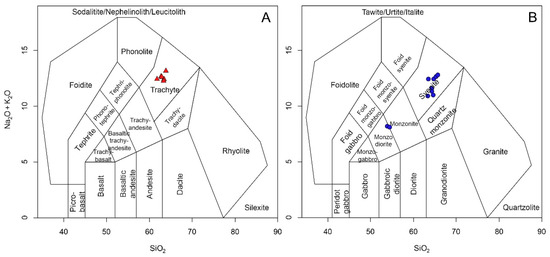
Figure 8.
TAS diagrams for classification of volcanic (A) and plutonic (B) rocks of the Soarinho intrusive complex.
The lithogeochemical data of the Soarinho complex were compared with neighboring intrusions (and of similar ages) (Figure 2). The lithogeochemical data of the Rio Bonito and Tanguá complexes were compiled from previous works [14,24]. The rocks of the Soarinho complex belong to the potassic series (Figure 9A), while the rocks of the complexes present a transitional character between the potassic and ultrapotassic series (Figure 9A).
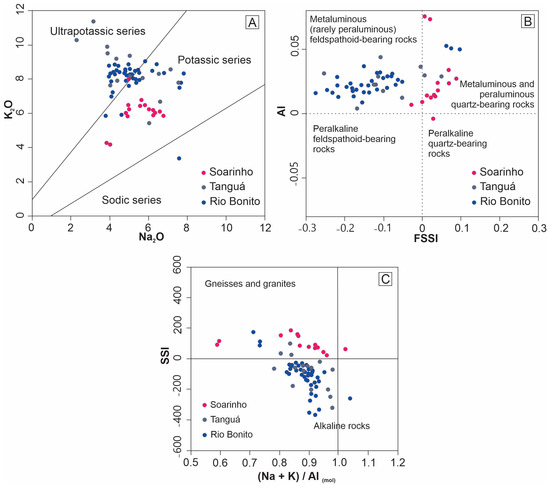
Figure 9.
Ultrapotassic, potassic, and sodic series diagram used to plot Soarinho, Rio Bonito, and Tanguá rocks (A). Al vs. SSI diagram with data from Soarinho, Rio Bonito, and Tanguá rocks (B). SSI vs. (N + K)/Al (mol) diagram with data from Soarinho, Rio Bonito, and Tanguá rocks (C) [14,24,42,43].
Regarding the alkalinity index (AI) and the feldspathoid silica saturation index (FSSI), the rocks of the Soarinho complex are, for the most part, metaluminous to peraluminous with the presence of normative quartz (Figure 9B). Regarding the silica saturation index, the rocks of the Soarinho complex are plotted in the upper field of the diagram, corresponding to the basement of granites and gneisses (Figure 9C).
All rocks in the Soarinho complex show enrichment in LREE compared to HREE (Figure 10). Alkali-feldspar syenites and alkali-feldspar trachytes show a strong negative Eu anomaly (Figure 10A,B). Samples of quartz syenite also show negative Eu anomalies; however, they are less pronounced (Figure 10C). The monzonite samples show mildly positive Eu anomalies (Figure 10D).
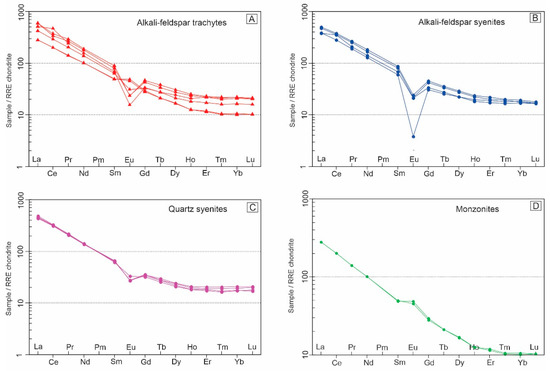
Figure 10.
Chondrite normalized REE diagrams for Soarinho rocks [44].
The multielement diagrams, normalized to the primitive mantle, demonstrate an enrichment pattern for mismatched elements (Figure 11). Alkali feldspar syenite and alkali feldspar trachyte samples show similar patterns in the multielement diagrams, showing strong depletions in Ba, Sr, P, and Ti (Figure 11A,B). The quartz syenite samples only show significant P and Ti depletion (Figure 11C). Finally, the monzonite samples show depletions in Ba and Sr (Figure 11D).
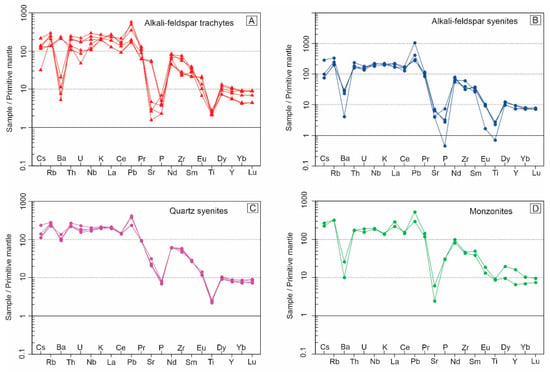
Figure 11.
Primitive mantle normalized multi-element diagrams for Soarinho rocks [45].
6. Zircon U-Pb Geochronology
Zircon U-Pb ages were obtained for samples SOA-01A (Quartz syenite), SOA-02A (monzonite), and SOA-05 (alkali-feldspar syenite) from Soarinho. We also dated one nepheline syenite sample from Tanguá. The analytical results are presented in Supplementary Material (SM) SD. Zircon grains generally have a short prismatic habit and well-defined oscillatory zoning. The luminescence cathode images of the analyzed zircon grains are presented in Supplementary Material SD.
Five zircon grains were used to calculate the crystallization age of sample SOA-01A, and the age obtained was 58 ± 2 Ma (Figure 12A), with an MSWD of 0.15 and a probability of 68%. In sample SOA-02A, 12 zircon grains were used to calculate the crystallization age, where 60 ± 2 Ma was obtained (Figure 12B), with MSWD = 0 and a probability of 99%. The age of 58 ± 2 Ma was obtained for sample SOA-05 from the analysis of 14 zircon grains (Figure 12C), with a MSWD of 0.01 and a probability of 95%. Twelve zircon grains were used to calculate the crystallization age of nepheline syenite, and the age obtained was 65 ± 1 Ma (Figure 12D), with MSWD = 0.0065 and a probability of 94%.
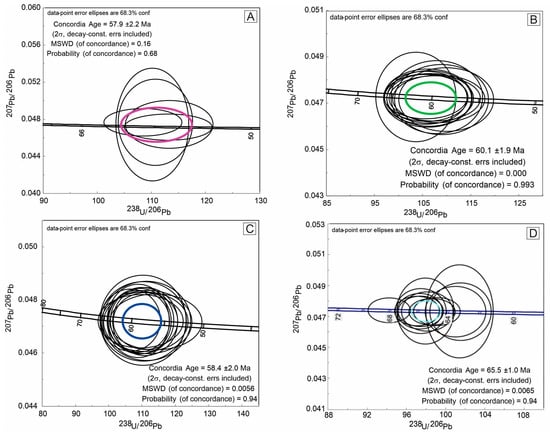
Figure 12.
Zircon U-Pb concord diagrams from quartz syenite (A), monzonite (B), alkali-feldspar syenite (C), and nepheline syenite (D).
7. Zircon Lu-Hf Isotopes
Lu-Hf analyses on zircon were performed on the same samples that U-Pb dating was performed on (SOA-01A, SOA-02A, SOA-05, and nepheline syenite). The complete analytical results are presented in the SM-E, and the data summary is presented in Table 4. Sample SOA-01A (syenite quartz) shows ƐHf (t) values ranging from −10.32 to −7.01 and model ages (TDM) varying between 1.2 and 1.4 Ga (Figure 13). Sample SOA-02A (monzonite) shows ƐHf(t) values ranging from −10.21 to −6.32 and model ages (TDM) ranging from 1.2 to 1.3 Ga (Figure 13). Sample SOA-05 (alkali-feldspar syenite) shows ƐHf(t) values ranging from −17.88 to −5.29 and model ages (TDM) ranging from 1.1 to 1.8 Ga (Figure 13). Nepheline syenite samples show ƐHf(t) values ranging from −6.4 to −32 and model ages (TDM) ranging from 1.1 to 2.8 Ga.

Table 4.
Summary of U-Pb and Lu-Hf data obtained for the SIC.
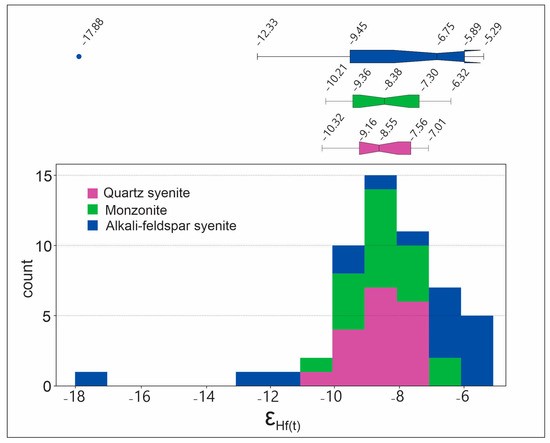
Figure 13.
Variation in epsilon Hf values in syenite, monzonite, and syenite alkali-feldspar samples. In the figure, the range of the epsilon Hf is demonstrated through histogram and boxplot diagrams.
8. Discussion
We chose to change the name of the Soarinho massif to Soarinho Intrusive Complex (SIC) due to the compositional variability of the rocks present and the presence of plutonic and volcanic rocks. Although the SIC is heterogeneous, attention is drawn to the compositional differences (geochemical and mineralogical) of all its rocks with neighboring intrusions (Tanguá and Rio Bonito) [14,24]. What most calls attention is the absence of nepheline (normative/modal) in the rocks of the SIC, which is present both in Tanguá and Rio Bonito.
The SIC rocks belong to the potassic series (Figure 9A) and are metaluminous to peraluminous with a predominance of normative quartz (Figure 9B). The presence of normative quartz demonstrates the saturated to weakly supersaturated silica character of the SIC rocks. The SSI index and the relationship between alkalis (Na and K) and aluminum (Figure 9C) demonstrate a strong influence of the host rocks in the magmatic processes that gave rise to the SIC. Analyzing the three diagrams in Figure 9, the chemical differences between the SIC and the neighboring massifs are evident.
The U-Pb ages also show differences between the SIC, Tanguá, and Rio Bonito massifs. The crystallization ages obtained in the SIC were 60 ± 2 Ma and 58 ± 2 Ma, while the crystallization age obtained in Tanguá and published data of the Rio Bonito massif is the same, 65 ± 1 Ma [14]. The age difference demonstrates that the SIC is younger than the Tanguá and Rio Bonito by around 4 to 8 Ma. All analyzed zircon grains have magmatic characteristics, such as well-defined oscillatory zoning, indicating no xenocrysts assimilated from the host rocks.
Some similarity between the SIC, Tanguá, and Rio Bonito can be observed in the isotopic data of Lu-Hf in zircon (Figure 14). The Lu-Hf data for the SIC point to an exclusively crustal component, where all ƐHf(t) values are negative, ranging between −17.88 and −5.29 (Figure 13). The quartz syenite and monzonite samples show less variation in the Lu-Hf data. In contrast, the alkali-feldspar syenite sample has a broader range of variation in the Lu-Hf data (Figure 13). Tanguá and Rio Bonito, in turn, present values of ƐHf(t) ranging between −32 and 5.6 and TDM model ages ranging between 1.1 and 2.8 Ga [14]. This range of overlap between the SIC and its neighbors demonstrates that the magmas that gave rise to these units present some connection, either by mixing different magmas or through the contamination of the magmas by the same host rocks.
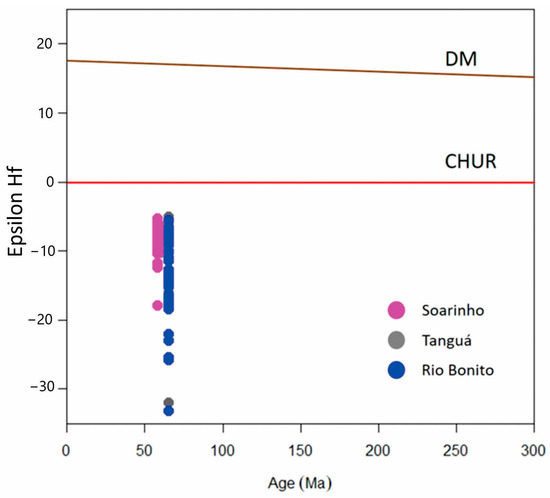
Figure 14.
Epsilon Hf evolution diagram with data from the Soarinho, Tanguá, and Rio Bonito massifs.
The SIC samples show similar patterns for rare earth elements, with a relative enrichment of light rare earth elements compared to heavy rare earth elements (Figure 10). Negative Eu anomalies are observed in the four distinct lithologies of the SIC, which suggests plagioclase fractionation during the process of magmatic evolution or plagioclase retention in the partially molten rock. The correlation matrices (Figure 7) demonstrate distinct evolution processes for the different SIC lithologies. For quartz syenite (QS), the highest correlation between P2O5 and TiO2 (0.99) suggests an essential fractionation of titanite, which is very common in alkaline rocks. Other significant correlations for QS are Fe2O3 × CaO, MgO × Fe2O3, and CaO × MgO, which suggest the fractionation of mafic minerals. In alkali-feldspar syenite (SY), the oxide pairs that show high correlations differ from the QS samples, indicating high linear correlations for several major oxide compounds. Finally, for the alkali-trachyte feldspar (TQ) samples, only two pairs of oxides show high linear correlations.
Magma mixing is suggested for the Soarinho intrusion, with mixing between a monzonite magma (36% to 44%) and an alkali feldspar syenite (56% to 64%) resulting in an overall quartz syenite composition. This model uses the mixing equation [46]—CH = (f × C1) + ((1 − f) × C2)—where C1, C2, and CH are the concentrations of a trace element in magma 1, magma 2, and the hybrid magma produced, respectively, and f is the proportion of magma 1 in the mixing. Figure 15 presents comparisons of a real quartz syenite (SOA-01B) and samples modeled by mixing monzonite and alkali feldspar syenite samples in different proportions. The diagrams show an overall good fit except for a few elements (Th, U, P, and Zr). This model is supported by binary diagrams and mantled phenocrysts found in quartz syenites, but it needs field data for confirmation.
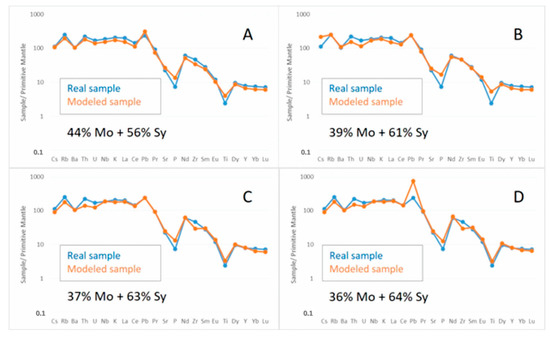
Figure 15.
Primitive mantle normalized [42] multi-elementary diagrams comparing a sampled quartz syenite (SOA-01B) with a model of mixing between monzonite and alkali feldspar syenite. All diagrams use the sample SOA-02A (monzonite) as magma 1, mixing it with the four-alkali feldspar syenites (SOA-05 (A), SOA-03 (B), SOA-06A (C), and SOA-06B (D)) as magma 2.
9. Conclusions
Our data show that the Soarinho Intrusive Complex is chemically and geochronologically different from Tanguá and Rio Bonito but presents some isotopic similarity with the latter. Zircon U-Pb ages for three Soarinho samples (monzonite, alkali feldspar syenite, and quartz syenite) show that Soarinho is about 4 to 8 Ma younger than Tanguá and Rio Bonito. Soarinho has a saturated to weakly supersaturated silica character, and its rocks present an absence of nepheline (normative/modal), whereas Tanguá and Rio Bonito have a predominant undersaturated and nepheline-bearing character. Geochemical parameters such as FSSI, SSI, and alkali-aluminum relationships show clear differences among Soarinho and its neighbors. Geochemical and zircon Lu-Hf isotopic data point to an enriched mantle source for Soarinho, but due to the presence of modal quartz in some samples, some crustal assimilation may have occurred in this intrusion.
Supplementary Materials
The following supporting information can be downloaded at: https://www.mdpi.com/article/10.3390/min13070904/s1, Supplementary Material SA: BB data; Supplementary Material SB: GJ1 data; Supplementary Material SC: Plesovice data; Supplementary Material SD: U-Pb analytical data; Supplementary Material SE: Lu-Hf analytical data.
Author Contributions
Conceptualization: D.A.d.S. and M.C.G.; Methodology: D.A.d.S. and M.C.G.; formal analysis: D.A.d.S.; investigation: D.A.d.S. and M.C.G.; resources: D.A.d.S. and M.C.G.; writing—review and editing: D.A.d.S. and G.L.P., visualization: D.A.d.S. and G.L.P. All authors have read and agreed to the published version of the manuscript.
Funding
This research received no external funding.
Acknowledgments
The present research work has been performed under the financial support of Rio de Janeiro State University (Universidade do Estado do Rio de Janeiro, UERJ) and also by Coordenação de Aperfeiçoamento de Pessoal de Nível Superior—(CAPES), Brazil. Activation Laboratories Ltd., Ontario, Canada, has performed the chemical analyses. The U-Pb and Lu-Hf analyses were carried out at the MultiLab Laboratory at Rio de Janeiro State University and the Isotope Geochemistry Laboratory at Ouro Preto Federal University, Brazil. The authors are grateful to the above-mentioned institutions and Fundação Carlos Chagas Filho de Amparo à Pesquisa do Estado do Rio de Janeiro, FAPERJ (project processes: E-26/203.112/2016 and E-26/204.531/2021 to GLP), Brazil, for financial support.
Conflicts of Interest
The authors declare no conflict of interest.
References
- Asmus, H.E. Geologia da margem continental brasileira. In Geologia do Brasil; Schobbenhaus, C., Campos, D.A., Derze, G.R., Asmus, H.E., Eds.; MME/DNPM: Brasília, Brazil, 1984; pp. 443–472. [Google Scholar]
- Mizusaki, A.M.P.; Thomaz-Filho, A.; Milani, E.J.; Césero, P. Mesozoic and Cenozoic igneous activity and its tectonic control in northeastern Brazil. J. S. Am. Earth Sci. 2002, 15, 183–198. [Google Scholar] [CrossRef]
- Riccomini, C.; Sant’Anna, L.G.; Ferrari, A.L. Evolução geológica do rift continental do Sudeste do Brasil. In Geologia do Continente Sul-Americano: Evolução da obra de Fernando Flávio Marques de Almeida; Mantesso-Neto, V., Bartorelli, A., Carneiro, C.D.R., Brito-Neves, B.B., Eds.; Editora Beca: São Paulo, Brazil, 2004; pp. 385–405. [Google Scholar]
- Ulbrich, H.; Gomes, C. Alkaline rocks from continental Brazil. Earth Sci. Rev. 1981, 17, 135–154. [Google Scholar] [CrossRef]
- Morbidelli, L.; Gomes, C.B.; Beccaluva Brotzu, P.; Conte, A.M.; Ruberti, E.; Traversa, G. Mineralogical, petrological and geochemical aspects of alkaline and alkaline-carbonatite associations from Brazil. Earth Sci. Rev. 1995, 39, 135–168. [Google Scholar] [CrossRef]
- Thompson, R.N.; Gibson, S.A.; Mitchell, J.G.; Dickin, A.P.; Leonardos, O.H.; Brod, J.A.; Greenwood, J.C. Migrating Cretaceous-Eocene magmatism in the Serra do Mar Alkaline Province, SE Brazil: Melts from the deflected Trinidade mantle plume? J. Petrol. 1998, 39, 1493–1526. [Google Scholar] [CrossRef]
- Heilbron, M.; Pedrosa-Soares, A.C.; Campos Neto, M.C.; Silva, L.C.; Truow, R.A.J.; Janasi, V.A. Geologia do Continente Sul-Americano: Evolução da Obra de Fernando Flávio Marques de Almeida; Província Mantiqueira, V., Mantesso-Neto, A., Bartoreli, C.D.R., Carneiro, B.B., Eds.; Brito-Neves: Beca, Brazil, 2004; pp. 203–234. [Google Scholar]
- Heilbron, M.; Eirado, L.G.; Almeida, J. Mapa Geológico e de Recursos Minerais do Estado do Rio de Janeiro. Escala 1:400.000 Programa Geologia do Brasil (PGB), Mapas Geológicos Estaduais. CPRM-Serviço Geológico do Brasil, Superintendência Regional de Belo Horizonte. 2016. Available online: https://www.researchgate.net/publication/312412824_Mapa_Geologico_e_de_Recursos_Minerais_do_Estado_do_Rio_de_Janeiro_Escala_1400000_Geological_Map_of_Rio_de_Janeiro_State_Brazil_1400000_scale (accessed on 20 March 2020).
- Amaral, G.; Bushee, J.; Cordani, U.G.; Kawashita, K.; Reynolds, J.H. Potassium-argon ages of alkaline rocks from Southern Brasil. Geochim. Cosmochim. Acta 1967, 31, 117–142. [Google Scholar] [CrossRef]
- Sonoki, I.K.; Garda, G.M. Idades K Ar de rochas alcalinas do Brasil Meridional e Paráguai Oriental: Compilação e adaptação às novas constantes de decaimento. Bol. IG USP Série Científica 1988, 19, 63–85. [Google Scholar] [CrossRef]
- Thomaz Filho, A.; Rodrigues, A.L. O alinhamento de rochas alcalinas Poços de Caldas Cabo Frio (RJ) e sua continuidade na cadeia Vitória Trindade. Braz. J. Geol. 1999, 29, 275–280. [Google Scholar] [CrossRef]
- Montes-Lauar, C.R.; Pacca, I.G.; Melfi, A.J.; Kawashita, K. Late Cretaceous Alkaline Complexes, Southeastern Brazil: Paleomagnetism and Geochronology. Earth Planet. Sci. Lett. 1995, 134, 425–440. [Google Scholar] [CrossRef]
- Silva, D.A.; Geraldes, M.C.; Vargas, T.; Jourdan, F.; Nogueira, C.C. 40Ar/39Ar age, lithogeochemistry and petrographic studies of the Cretaceous Alkaline Marapicu Intrusion, Rio de Janeiro, Brazil. Bol. Do Mus. Para. Emílio Goeldi Ciências Nat. 2015, 10, 399–422. [Google Scholar] [CrossRef]
- Da Silva, D.A.; Motoki, A.; Dos Santos, A.C.; Mendes, J.; Jourdan, F.; Geraldes, M.C.; Lana, C.D.C. Multiple processes of geochemical evolution for the alkaline rocks of Rio Bonito intrusive complex, State of Rio de Janeiro, Brazil: 40Ar/39Ar and U-Pb ages and Lu-Hf isotopes on zircon and constraints on crustal signature. Geol. USP. Série Científica 2020, 20, 213–234. [Google Scholar] [CrossRef]
- Herz, N. Timing of Spreading in the South Atlantic: Information from Brazilian Alkali Rocks. Geol. Soc. Am. Bull. 1977, 88, 101–112. [Google Scholar] [CrossRef]
- Gibson, S.A.; Thompson, R.N.; Leonardos, O.H.; Dickin, A.P.; Mitchel, J.G. The late cretaceous impact of the Trindade Mantle Plume: Evidence from large-volume, mafic, potassic magmatism in SE Brazil. J. Petrol. 1995, 36, 189–229. [Google Scholar] [CrossRef]
- Almeida, F.F.M. The system of continental rifts bordering the Santos basin, Brazil. An. Acad. Bras. Ciências 1976, 48 (Suppl.), 15–26. [Google Scholar]
- Almeida, F.F.M.; Neves, B.B.B.; Carneiro, C.D.R. The origin and evolution of the South American Platform. Earth Sci. Rev. 2000, 50, 77–111. [Google Scholar] [CrossRef]
- Oreiro, S.G.; Cupertino, J.A.; Szatmari, P.; Thomaz Filho, A. Influence of pre salt alignments in post Aptian magmatism in the Cabo Frio High and its surroundings, Santos and Campos basins, SE Brazil: An example of non plume related magmatism. J. S. Am. Earth Sci. 2008, 25, 116–131. [Google Scholar] [CrossRef]
- Fainstein, R.; Summerhayes, C.P. Structure and origin of marginal banks off Eastern Brazil. Mar. Geol. 1982, 46, 199–215. [Google Scholar] [CrossRef]
- Mota, C.E.M.; Geraldes, M.C.; Almeida, J.C.H.; Vargas, T.; Souza, D.M.; Loureiro, R.O.; Silva, A.P. Características Isotópicas (Nd e Sr), Geoquímicas e Petrográficas da Intrusão Alcalina do Morro de São João: Implicações Geodinâmicas e Sobre a Composição do Manto Sublitosférico. Geol. USP Série Científica 2009, 9, 85–100. [Google Scholar] [CrossRef]
- Brotzu, P.; Beccaluva, L.; Conte, A.; Fonseca, M.; Garbarino, C.; Gomes, C.B.; Leong, R.; Macciotta, G.; Mansur, R.L.; Melluso, L.; et al. Petrological and geochemical studies of alkaline rocks from continental Brazil. 8. The syenitic intrusion of Morro Redondo, RJ. Geochim. Bras. 1989, 3, 63–80. [Google Scholar]
- Brotzu, P.; Barbieri, M.; Beccaluva, L.; Garbarino, C.; Gomes, C.B.; Macciotta, G.; Melluso, L.; Morbidelli, L.; Ruberti, E.; Sigolo, J.B.; et al. Petrology and geochemistry of the Passa Quatro alkaline complex, southeastern Brazil. J. S. Am. Earth Sci. 1992, 6, 237–252. [Google Scholar] [CrossRef]
- Motoki, A.; Sichel, S.E.; Vargas, T.; Aires, J.R.; Iwanuch, W.; Mello, S.L.M.; Motoki, K.F.; Silva, S.; Balmant, A.; Gonçalves, J. Geochemical evolution of the felsic alkaline rocks of Tanguá, Rio Bonito, and Itaúna intrusive bodies, State of Rio de Janeiro, Brazil. Geociências 2010, 29, 291–310. [Google Scholar]
- Motoki, A.; Araújo, A.L.; Sichel, S.E.; Geraldes, M.C.; Jourdan, F.; Motoki, K.F.; Silva, S. Nepheline syenite Magma Differentiation with Continental Crustal Assimilation for the Cabo Frio Island Intrusive Complex, State of Rio de Janeiro, Brazil. Geociências 2013, 32, 195–218. [Google Scholar]
- Shea, M.E. Isotopic geochemical characterization of selected nepheline syenites and phonolites from the Poços de Caldas alkaline complex, Minas Gerais, Brazil. J. Geochem. Explor. 1992, 45, 173–214. [Google Scholar] [CrossRef]
- Ulbrich, H.H.; Vlach, S.R.F.; Demaiffe, D.; Ulbrich, M.N.C. Structure and origin of the Poços de Caldas Alkaline Massif. In Mesozoic to Cenozoic Alkaline Magmatism in the Brazilian Platform; Comin-Chiaramonti, P., Gomes, C.B., Eds.; Edusp/Fapesp: São Paulo, Brazil, 2005; pp. 367–418. [Google Scholar]
- Grohmann, C.H.; Riccomini, C.; Alves, F.M. SRTM-based morphotectonic analysis of the Poços de Caldas Alkaline Massif, southeastern Brazil. Comput. Geosci. 2007, 33, 10–19. [Google Scholar] [CrossRef]
- Takenaka, L.B.; Lana, C.; Scholz, R.; Nalini, H.A., Jr.; Abreu, A.T. Optimization of the in-situ U–Pb age dating method via LA-Quadrupole-ICP-MS with applications to the timing of U–Zr–Mo mineralization in the Poços de Caldas Alkaline Complex, SE Brazil. J. S. Am. Earth Sci. 2015, 62, 70–79. [Google Scholar] [CrossRef]
- Brotzu, P.; Gomes, C.B.; Melluso, L.; Morbidelli, L.; Morra, V.; Ruberti, E. Petrogenesis of coexisting SiO2-undersaturated to SiO2-oversaturated felsic igneous rocks: The alkaline complex of Itatiaia, Southeastern Brazil. Lithos 1997, 40, 133–156. [Google Scholar] [CrossRef]
- Rosa, P.A.S.; Ruberti, E. Nepheline syenite to syenites and granitic rocks of the Itatiaia Alkaline Massif, Southeastern Brazil: New geological insights into a migratory ring Complex. Braz. J. Geol. 2018, 48, 347–372. [Google Scholar] [CrossRef]
- Valença, J.G. Geology, Petrography and Petrogenesis of Some Alkaline Igneous Complexes of Rio de Janeiro State, Brazil. Ph.D. Thesis, West Ontario University, London, ON, Canada, 1980; 247p. [Google Scholar]
- Silva, D.A.; Geraldes, M.C.; Rodrigues, S.W.O.; Mcmaster, M.; Evans, N.; Nummer, A.R.; Vargas, T. (U Th)/He Ages from the Fluorite Mineralization of the Tanguá Alkaline Intrusion. Anuário Inst. Geociências UFRJ 2018, 41, 14–21. [Google Scholar] [CrossRef]
- Janousek, V.; Farrow, C.M.; Erban, V. Interpretation of whole-rock geochemical data in igneous geochemistry: Introducing geochemical data toolkit (GCDkit). J. Petrol. 2006, 47, 1255–1259. [Google Scholar] [CrossRef]
- Ludwig, K.R. Using Isoplot/Ex, Version 3.00, a Geochronological Toolkit for Microsoft Excel; Berkeley Geochronology Center Special Publication: Berkeley, CA, USA, 2003; Volume 4, p. 74. [Google Scholar]
- Tera, F.; Wasserburg, G.J. U-Th-Pb systematic in three Apolo 14 basalts and the problem of initial Pb in lunar rocks. Earth Planet. Sci. Lett. 1972, 14, 281–304. [Google Scholar] [CrossRef]
- Bouvier, A.; Vervoort, J.D.; Patchett, P.J. The Lu-Hf and Sm-Nd isotopic composition of CHUR: Constraints from unequilibrated chondrites and implications for the bulk composition of terrestrial planets. Earth Planet. Sci. Lett. 2008, 273, 48–57. [Google Scholar] [CrossRef]
- Söderlund, U.; Patchett, P.J.; Vervoort, J.D.; Isachsen, C.E. The 176Lu decay constant determined by Lu-Hf and U-Pb isotope systematics of Precambrian mafic intrusions. Earth Planet. Sci. Lett. 2004, 219, 311–324. [Google Scholar] [CrossRef]
- Chauvel, C.; Lewin, E.; Carpentier, M.; Arndt, N.T.; Marini, J.C. Role of recycled oceanic basalt and sediment in generating the Hf-Nd mantle array. Nat. Geosci. 2008, 1, 64–67. [Google Scholar] [CrossRef]
- Blichert-Toft, J. The Hf isotopic composition of zircon reference material 91500. Chem. Geol. 2008, 253, 252–257. [Google Scholar] [CrossRef]
- Dhuime, B.; Hawkesworth, C.; Cawood, P. When Continents Formed. Science 2011, 331, 154–155. [Google Scholar] [CrossRef] [PubMed]
- Frost, B.R.; Frost, C.D. A Geochemical Classification for Feldspatic Igneous Rocks. J. Petrol. 2008, 49, 1955–1969. [Google Scholar] [CrossRef]
- Middlemost, E.A.K. The basalt clan. Earth Sci. Rev. 1975, 11, 337–364. [Google Scholar] [CrossRef]
- Boynton, W.V. Cosmochemistry of the rare-earth elements: Meteorite studies. In Rare-Earth Elements Geochemistry; Henderson, P., Ed.; Elsevier: Amsterdam, The Netherlands, 1984; pp. 63–114. [Google Scholar]
- Sun, S.; Mcdonough, W.F. Chemical and isotopic systematics of oceanic basalts: Implications for mantle composition and processes. In Magmatism in the Ocean Basins; Saunders, A.D., Norry, M.J., Eds.; Blackwell Scientific: Boston, MA, USA, 1989; pp. 313–345. [Google Scholar]
- Powell, R. Inversion of the assimilation and fractional crystallization (AFC) equations; characterization of contaminants from isotope and trace element relationships in volcanic suites. J. Geol. Soc. Lond. 1984, 141, 447–552. [Google Scholar] [CrossRef]
Disclaimer/Publisher’s Note: The statements, opinions and data contained in all publications are solely those of the individual author(s) and contributor(s) and not of MDPI and/or the editor(s). MDPI and/or the editor(s) disclaim responsibility for any injury to people or property resulting from any ideas, methods, instructions or products referred to in the content. |
© 2023 by the authors. Licensee MDPI, Basel, Switzerland. This article is an open access article distributed under the terms and conditions of the Creative Commons Attribution (CC BY) license (https://creativecommons.org/licenses/by/4.0/).